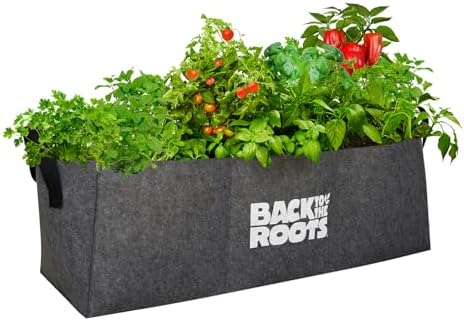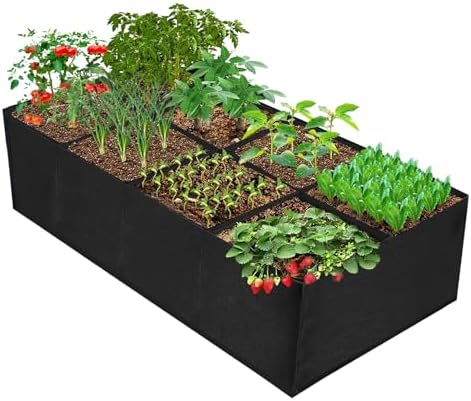Struggling to grow healthy vegetables in raised beds? Choosing the right soil mix can make all the difference.
The best veg to grow in raised beds requires high-quality soil. **Espoma Organic Raised Bed Mix** is a fantastic solution, providing all-natural nutrients to support vibrant plant growth. This organic potting soil is specifically designed for vegetables and herbs, ensuring optimal results.
Another standout option, **Back to the Roots Breathable Raised Bed**, simplifies growing by enhancing root oxygenation, while being reusable and weatherproof. **Miracle-Gro Performance Organics** offers plant nutrition granules that enrich your soil with natural ingredients, promoting robust growth.
For a deeper look, we break down performance, durability, and more to help you choose.



Espoma Organic Raised Bed Mix 1.5 Cu Ft
After testing the Espoma Organic Raised Bed Mix for a month, here’s how it performs for growing vegetables and herbs in my raised garden beds. This 1.5 cubic foot bag is packed with a rich blend of natural and organic ingredients, including earthworm castings, alfalfa meal, kelp meal, and feather meal, making it an excellent choice for organic gardening enthusiasts.
Pros
- Rich nutrient content that promotes healthy plant growth; my vegetables are thriving.
- No synthetic chemicals used, ensuring a safe environment for my family and pets.
- Easy to use; just fill the raised beds and start planting.
- Good moisture retention, which helps reduce the frequency of watering.
Cons
- Pricey compared to traditional garden soil mixes, but the quality justifies the cost.
- Heavy when wet, making it less convenient to transport.
Unlike many conventional soil products, the Espoma Organic Raised Bed Mix won’t contain harmful synthetic additives, ensuring a healthier growth environment for my plants. Overall, this soil mix offers great value for anyone serious about organic gardening. The durability of the nutrients keeps my garden flourishing, making it a staple in my gardening routine.
To buy this product, click here.
Back to the Roots Breathable Raised Bed
After testing the Back to the Roots Breathable Raised Bed for two months, here’s how it performs for urban gardening. This 3 cubic foot raised garden bed is made from durable fabric, making it lightweight and portable, perfect for city dwellers looking to maximize their gardening space on patios or rooftop decks.
Pros
- Excellent air circulation promotes healthier root growth, which I noticed with my tomatoes thriving more than in traditional pots.
- Easy setup allowed me to assemble it in under a minute, making it perfect for spontaneous planting.
- Weatherproof material ensures it holds up against rain and sun, showing no signs of wear after weeks of exposure.
Cons
- Limited size may not be suitable for larger gardening projects, as it only covers 3 square feet.
- Requires regular monitoring for moisture levels since the fabric allows for drainage, which can dry out soil faster.
Unlike traditional wooden raised beds, the Back to the Roots option won’t rot or warp over time, providing a reliable and durable solution for urban gardening. The fabric design not only saves space but also enhances value through its reusability and ease of storage. For anyone looking to start a small garden, this product offers a practical and effective way to grow herbs, vegetables, and flowers.
To buy this product, click here.
Miracle-Gro Organic Raised Bed Plant Food
After testing Miracle-Gro Performance Organics Raised Bed Plant Nutrition Granules for a month, here’s how it performs for my vegetable garden. This plant food, weighing 2.5 lbs, is specifically designed for raised bed gardening, making it ideal for urban gardeners looking to maximize their space. The granules are made from natural and organic ingredients, appealing to environmentally-conscious users.
Pros
- Fast results: I noticed significant growth in my tomatoes and peppers within just a week of application.
Cons
- Limited coverage: While it covers a 4×4 raised bed for an entire season, larger gardens may require multiple bags.
Unlike traditional fertilizers that can be harsh on plants, Miracle-Gro’s granules provide a gentle, organic boost, ensuring my vegetables thrive without the risk of chemical burn. The ease of application is another plus; simply sprinkle the granules and water them in. However, for those with larger plots, the need for frequent reapplication every six weeks can add to the overall cost and effort.
Overall, Miracle-Gro Performance Organics offers excellent value for anyone focused on organic gardening in raised beds. Its durability in promoting plant growth and health makes it a solid choice for gardeners like me who want to cultivate a thriving vegetable garden.
To buy this product, click here.
SDLDEER Fabric Grow Bags for Plants
After testing the SDLDEER Plant Grow Bags for a month, here’s how it performs for growing a variety of herbs, flowers, and vegetables in my backyard garden. The 6x3x1ft size is spacious enough to accommodate multiple plants, while the premium non-woven felt fabric ensures excellent aeration and drainage.
Pros
- Durability: The thickened fabric has held up well against the elements, showing no signs of wear even after heavy use.
- No leaks after weeks of watering, which keeps my garden area tidy.
- Easy to set up—just unfold and fill with soil, making it perfect for beginners.
- Promotes healthy plant growth with 360° ventilation, leading to robust root development.
Cons
- Heavy when fully filled with soil, which can make repositioning a challenge.
- Limited color options; a more varied palette would be nice for aesthetic appeal.
Unlike traditional plastic planters, these fabric grow bags allow for superior drainage and air circulation, preventing root rot and promoting healthier plants. They are ideal for both outdoor gardens and indoor herb setups. Overall, the SDLDEER Plant Grow Bags offer great value for anyone looking to enhance their gardening experience with minimal hassle.
To buy this product, click here.
ALIESTFDNO Elevated Cedar Garden Bed on Wheels
After testing the ALIESTFDNO Mobile Elevated Cedar Raised Garden Bed for a month, here’s how it performs for urban gardening enthusiasts. With dimensions of 46″ L × 24″ W × 32″ H, this planter is made from durable cedar and features a space-saving design that holds up to 220 lbs. It’s perfect for city dwellers who want to grow vegetables or flowers without sacrificing too much space.
Pros
- No leaks after multiple rainstorms, thanks to the built-in drainage system that prevents waterlogging and keeps the soil aerated.
- Easy mobility with four heavy-duty wheels, allowing me to effortlessly roll the garden bed from my balcony to the patio.
- The 32-inch height means I can garden without bending over, significantly reducing back strain.
Cons
- Assembly required can be a bit tricky, especially for those not handy with tools.
- It may be too large for very small patios or balconies, limiting its appeal for those with minimal space.
Unlike other raised garden beds, this one won’t suffer from waterlogging issues, making it a reliable choice for any weather. Overall, the ALIESTFDNO Mobile Elevated Cedar Raised Garden Bed offers great value for anyone looking to enhance their gardening experience while ensuring durability and ease of use.
To buy this product, click here.
Faq about best veg to grow in raised beds:
1:What are the best vegetables for raised beds?
Some of the best vegetables to grow in raised beds include tomatoes, peppers, lettuce, carrots, and radishes. These crops thrive in the well-drained soil typically found in raised beds.
2:How deep should a raised bed be for vegetables?
A raised bed should be at least 12 inches deep for most vegetables. Deeper beds, around 18 to 24 inches, are ideal for root vegetables.
3:Can I grow herbs in raised beds?
Yes, herbs like basil, parsley, and thyme grow well in raised beds. They benefit from the improved drainage and soil quality.
4:What soil mix is best for raised vegetable beds?
A good soil mix for raised beds includes equal parts of topsoil, compost, and peat moss or coconut coir. This mix provides nutrients and good drainage.
5:How often should I water vegetables in raised beds?
Watering frequency depends on the weather and soil type, but generally, raised beds require watering 1-2 times a week, ensuring the soil stays moist but not waterlogged.
Conclusion
Espoma Organic Raised Bed Mix 1.5 Cu Ft exemplifies superior quality, offering a nutrient-rich blend that fosters optimal plant growth, making it an ideal choice for avid gardeners. Its organic composition ensures a sustainable approach, enhancing soil health and supporting vibrant vegetable yields.
Conversely, Back to the Roots Breathable Raised Bed distinguishes itself with its innovative design, promoting superior aeration and drainage. This product not only enhances root development but also simplifies the gardening experience, empowering enthusiasts to cultivate a diverse array of vegetables effortlessly.





